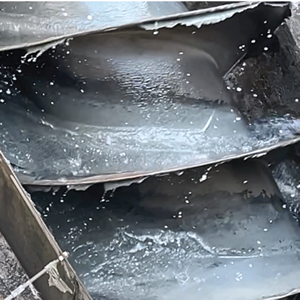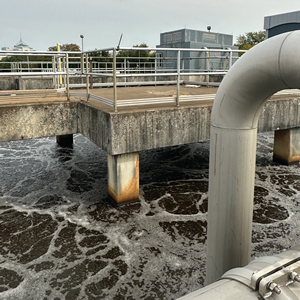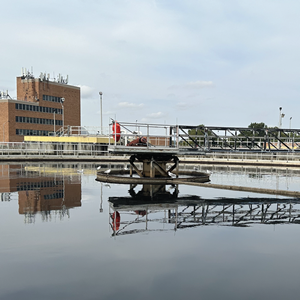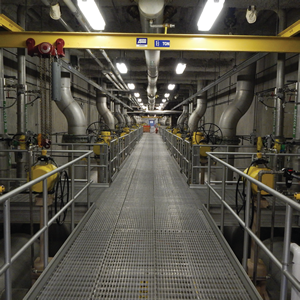Wastewater includes substances like human waste, food scraps, oils, soaps, and chemicals. In homes, wastewater comes from sinks, showers, bathtubs, toilets, washing machines, and dishwashers. Businesses and industries also produce wastewater. Wastewater treatment is the process of converting wastewater into water that can be discharged back into the environment.
|
According to the U.S. Environment Protection Agency, wastewater treatment one of the most common forms of pollution control in the U.S. Wastewater contains bacteria, viruses and disease-causing pathogens which can negatively impact human health. Decaying organic matter, debris, and other substances in wastewater are also known to cause harm to fish, wildlife and their natural habitat.
|
|
The Wastewater Treatment Process
For the most part, the wastewater treatment process is a natural process. Treatment facilities are designed to speed up the natural process of purifying water because the natural process wouldn’t be able to clean the billions of gallons of wastewater produced in today’s world.
|
|
Preliminary treatment is the first step to treating wastewater when it comes into the facility. It’s main purpose is to get rid of the larger solids and debris.
Screening is a critical first step in wastewater treatment. Larger items found in wastewater can create blockages and damage facility equipment. The screening process is the same principle as sifting dirt or sand. As the size of the screen decreases, it catches smaller particles. Screens are paired with rakes. The rake’s job is to prevent the screens from clogging by removing the debris they catch. Screenings usually consist of garbage, rags, leaves, sticks and wipes.
To remove the smaller debris that passes through the screens, wastewater travels through a grit chamber. A grit chamber is a long, circular tank that slows the flow of the water, allowing heavier particles, like sand and gravel to settle to the bottom of the tank.
Primary treatment is similar to preliminary treatment in its purpose to remove solids from the wastewater.
Primary settling tanks hold wastewater for a few hours and let gravity do it’s thing. Solids gradually sink to the bottom of these tanks. The settled solids, known as sludge, are collected from the bottom of the tank and removed. Mechanical arms at the top of the primary settling tanks skim the surface of the water, removing grease and other floatables.
|
|
ACTIVATED SLUDGE AERATION TANKS
Secondary treatment is a bubbling brew of biological activity. Microorganisms are introduced to the wastewater in activated sludge aeration tanks, where they feed on the organic matter and suspended solids leftover from primary treatment. Dissolved oxygen is added into the mixture, creating the ideal environment for the microorganisms to thrive, creating an active, healthy suspension of biological solids, mostly made of bacteria, which is called activated sludge. Time in the tank allows the microorganisms to absorb the organic materials.
SECONDARY CLARIFIER
After several hours, the brew moves into settling tanks, where the activated sludge created in the aeration tanks, settles out of the water, similar to the primary settling tanks.
|
|
|
After secondary treatment is complete, the wastewater looks clean and roughly 85% to 90% of the organic matter has been removed. At this point, water is safe to be released to the environment. To enhance water quality further, WEP's treatment plants use tertiary treatment.
Ammonia is toxic to fish and takes a lot of oxygen from water as it converts to nitrates. As nitrates, the nutrient promotes the growth of algae. Ammonia and nitrates in the water result in excessive nutrients causing dense growth of plant life and death of animal life from the lack of oxygen.
Like nitrogen, high levels of phosphorous in wastewater can cause the dense growth of plant life and upset the surrounding habitat. Phosphorous encourages algae growth. Limited quantities of algae are beneficial, but too much can lead to problems.
The warmer months in Central New York are prime time for pathogens. To ensure water quality standards are met, WEP implements seasonal disinfection during this time.
Chlorination
Chlorine is used to kill or inactivate harmful microorganisms such as bacteria, viruses, and protozoa that can pose health risks. Chlorine is added to the treated wastewater and held in a chlorine contact tank to ensure the chlorine's effectiveness in killing pathogens. To protect aquatic life, residual chlorine is neutralized before the water is released to the environment.
UV
UV disinfection uses short-wavelength ultraviolet light to inactivate microorganisms by damaging their DNA and RNA, preventing them from reproducing and causing infections. UV offers reliable disinfection without the use of chemicals.
That’s how wastewater becomes clean water! |
|
| |
|
|
|
| |
|
|







